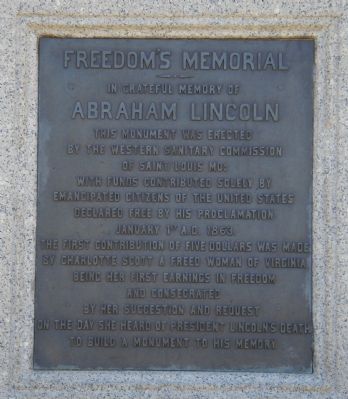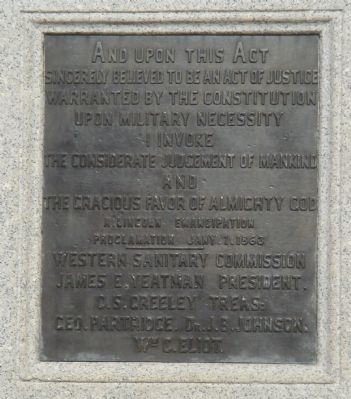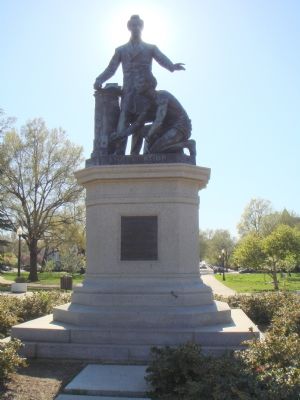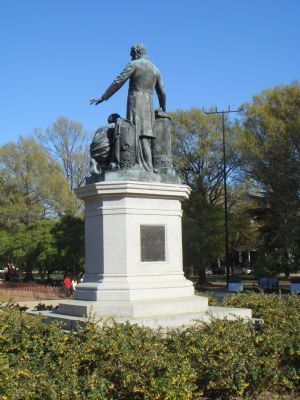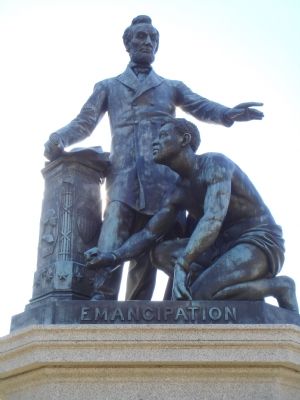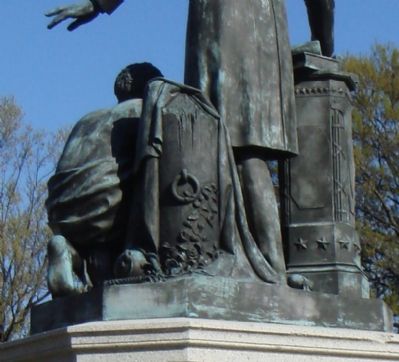Capitol Hill in Northeast Washington in Washington, District of Columbia — The American Northeast (Mid-Atlantic)
Freedmenís Memorial Monument to Abraham Lincoln
or
Freedomís Memorial
In grateful memory of Abraham Lincoln.
This monument was erected by the Western Sanitary Commission of Saint Louis, Mo., with funds contributed solely by emancipated Citizens of the United States declared free by his Proclamation, January 1st A.D. 1863. The first contribution of five dollars was made by Charlotte Scott, a freed woman of Virginia, being her first earnings in freedom and consecrated by her suggestion and request, on the day she heard of President Lincolnís death, to build a monument to his memory.
And upon this act, sincerely believed to be an act of justice, warranted by the Constitution upon military necessity, I invoke the considerate judgment of mankind, and the gracious favor of Almighty God. — A. Lincoln, Emancipation Proclamation, Jan 1, 1863.
Western Sanitary Commission, James E. Yeatman, President. C. S. Creeley, Treas. Ceo. Partridge, Dr. J.B. Johnson, Wm. C. Eliot.
Erected 1876 by the Western Sanitary Commission.
Topics and series. This historical marker is listed in these topic lists: Abolition & Underground RR • African Americans • Civil Rights • War, US Civil. In addition, it is included in the Former U.S. Presidents: #16 Abraham Lincoln series list. A significant historical date for this entry is January 1, 1784.
Location. 38° 53.389′ N, 76° 59.416′ W. Marker is in Northeast Washington in Washington, District of Columbia. It is in Capitol Hill. Marker is at the intersection of East Capitol Street Northeast and 12th Street Northeast, in the median on East Capitol Street Northeast. It is in Lincoln Park, which is bounded by 11th and 13th Streets Northeast, where North Carolina and Massachusetts Avenues cross, and Kentucky and Tennessee Avenues begin. Touch for map. Marker is at or near this postal address: 1196 East Capitol Street Northeast, Washington DC 20003, United States of America. Touch for directions.
Other nearby markers. At least 8 other markers are within walking distance of this marker. Mary McLeod Bethune (about 300 feet away, measured in a direct line); Carolina Theatre (about 400 feet away); Lola Beaver Memorial Park (approx. 0.2 miles away); The Furies House (approx. 0.2 miles away); Home Theatre 1916-1951 (approx. ľ mile away); John W. Harrod (approx. 0.4 miles away); Eastern Market (approx. 0.4 miles away); Meet You At the Market (approx. 0.4 miles away). Touch for a list and map of all markers in Northeast Washington.
More about this marker. The quote is the famous last sentence of the Emancipation Proclamation. The former slave depicted on the statue was said to be modeled on Archer Alexander, the last slave to be recaptured under the federal Fugitive Slave Act.
Regarding Freedmenís Memorial Monument to Abraham Lincoln. Abraham Lincoln reads the Proclamation as he extends his hand over the head of a slave, shackles still on his wrists, but with chains cut. Behind them (Photo 6) are the symbols of slavery: a whip, a ball and chain, and a whipping post which has been chopped down and covered with cloth. A a rose vine is beginning climb over the symbols to obscure and destroy them.
Also see . . .
1. Lincoln Park. National Park Service website entry (Submitted on August 16, 2007, by K. Philbin of Bellefonte, Pennsylvania.)
2. Emancipation Group. Teacher Vistion website entry:
Story of the replica Freedom's Memorial (a.k.a. the "Emancipation Group") in Boston, MA. (Submitted on December 23, 2007, by Richard E. Miller of Oxon Hill, Maryland.)
3. Archer Alexander. Wikipedia biography (Submitted on March 13, 2011, by Richard E. Miller of Oxon Hill, Maryland.)
Additional commentary.
1. Frederick Douglassí Oration at the Unveiling
The complete New York Times article published April 22, 1876.
DOUGLASS ON LINCOLN, The Colored Manís Estimate of the Great Emancipator.
In his oration at the unveiling of the colored menís statue of Abraham Lincoln in Washington, on the late anniversary of his assassination, Frederick Douglass said:
“We fully comprehend the relation of Abraham Lincoln, both to ourselves and the white people of the United States. Truth is proper and beautiful at all times and in all places, and it is never more proper and beautiful in any case than when speaking of a great public man whose example is likely to be commended for honor and imitation long after his departure to the solemn shades, the silent continents of eternity. It must be admitted, truth compels me to admit, even here in the presence of the monument we have erected to his memory, Abraham Lincoln was not, in the fullest sense of the word, either our man or our model. In his interests, in his associations, in his habits of thought, and in his prejudices, he was a white man. He was preeminently the white manís President, entirely devoted to the welfare of white men. He was ready and willing at any time during the first wars of his Administration to deny, postpone, and sacrifice the rights of humanity in the colored people to promote the welfare of the white people of this country.
“In all his education and feeling he was an American of the Americans. He came into the Presidential chair upon one principle alone, namely, opposition to the extension of slavery. His arguments in furtherance of this policy had their motive and mainspring in his patriotic devotion to the interests of his own race. To protect, defend, and perpetuate slavery in the States where it existed, Abraham Lincoln was not less ready than any other President to draw the sword of the nation. He was ready to execute all the supposed constitutional guarantees of the Constitution in favor of the slave system anywhere inside the slave States. He was willing to pursue, recapture, and send back the fugitive slave to his master, and to suppress a slave rising for liberty, though his guilty master were already in arms against the Government. The race to which we belong were not the special objects of his consideration.
“Knowing this, I concede to you, my white fellow-citizens, a pre-eminence in this worship at once full and supreme. First, midst, and last, you and yours were the object of his deepest affection and his most earnest solicitude. You are the children of Abraham Lincoln. We are at best only his step-children, children by adoption, children by force of circumstances and necessity. To you it especially belongs to sound his praises, to preserve and perpetuate his memory, to multiply his statues, to hang his pictures on your walls, and commend his example, for to you he was a great and glorious friend and benefactor. Instead of supplanting you at this altar, we would exhort you to build high his monuments; let them be of the most costly material, of the most cunning workmanship; let their bases be symmetrical, beautiful, and perfect; let their bases be upon solid rocks, and their summits lean against the unchanging blue overhanging sky, and let them endure forever! But while in the abundance of your wealth and in the fullness of your just and patriotic devotion, you do all this, we entreat you to despise not the humble offering we this day unveil to view; for while Abraham Lincoln saved for you a country, he delivered us from a bondage, according to Jefferson, one hour of which was worse than ages of the oppression your fathers rose in rebellion to oppose.
“When he tarried long in the mountain; when he strangely told us that we were the cause of the war; when be still more strangely told us to leave the land in which we were born; when he refused to employ our arms in defense of the Union; when, after accepting our services as colored soldiers, he refused to retaliate when we were murdered as colored prisoners; when he told us he would save the Union if he could with slavery; when he revoked the proclamation of emancipation of Gen. Fremont; when he refused to remove the Commander of the Army of the Potomac, who was more zealous in his efforts to protect slavery than to suppress rebellion — when we saw all this, and more, we were at times stunned, grieved, and greatly bewildered; but our hearts believed while they ached and bled. Nor was this, even at that time, a blind and unreasoning superstition.
“Despite the mist and haze that surrounded him; despite the tumult, the hurry, and confusion of the hour, we were able to take a comprehensive view of Abraham Lincoln, and to make reasonable allowance for the circumstances of his position. We saw him, measured him, and estimated him; not by stray utterances to injudicious and tedious delegations, who often tried his patience; not by isolated facts torn from their connection; not by any partial and imperfect glimpses, caught at inopportune moments; but by a broad survey, in the light of the stern logic of great events—and in view of that Divinity which shapes our ends rough-hew them as we will, we came to the conclusion that the hour and the man of our redemption had met in the person of Abraham Lincoln. It mattered little to us what language he might employ upon special occasions; it mattered little to us, when we fully knew him, whether he was swift or slow in his movements; it was enough for us that Abraham Lincoln was at the head of a great movement, and was in living and earnest sympathy with that movement, which, in the nature of things, must go on till slavery should be utterly and forever abolished in the United States.
“When, therefore, it shall be asked what we have to do with the memory of Abraham Lincoln or what Abraham Lincoln had to do with us? the answer is ready, full, and complete. Though he loved Caesar less than Rome, though the Union was more to him than our freedom or our future, under his wise and beneficent rule we saw ourselves gradually lifted from depths of slavery to the heights of liberty and manhood; under his wise and beneficent rule, and by measures approved and vigorously pressed by him, we saw that the handwriting of ages, in the form of prejudice and proscription, was rapidly fading away from the face of our whole country; under his rule and in due time, about as soon after all as the country could tolerate the strange spectacle, we saw our brave sons and brothers laying off the rags of bondage, and being clothed all over in the blue uniforms of the soldiers of the United States; under his rule we saw two hundred thousand of our dark and dusky people responding to the call of Abraham Lincoln, and, with muskets on their shoulders and eagles on their buttons, timing their high footsteps to liberty and union under the national flag; under his rule we saw the independence of the Republic of Hayti, the special object of slaveholding aversion and horror, fully recognized, and her Minister, a colored gentleman, duly received here in the City of Washington; under his rule we saw the internal slave trade, which so long disgraced the nation, abolished, and slavery abolished in the District of Columbia; under his rule we saw for the first time the law enforced against
the foreign slave trade, and the first slave-trader hanged like any other pirate or murderer; under his rule and inspiration we saw the Confederate States, based upon the idea that our race must be slaves and slaves forever, battered to pieces and scattered to the four winds; under his rule and in the fullness of time, we saw Abraham Lincoln, after giving the slave-holders three months of grace, in which to save their hateful slave system, penning the immortal paper, which, though special in its language, was general in its principles and effect, making slavery forever impossible in the United States. Though we waited long we saw all this and more.
“Viewed from the genuine abolition ground, Mr. Lincoln seemed tardy, cold, dull and indifferent; but measuring him by the sentiment of his country, a sentiment he was bound as a statesman to consult, he was swift, zealous, radical, and determined. Though Mr. Lincoln shared the prejudices his white fellow-countrymen against the negro, it is hardly necessary to say that in his heart of hearts he loathed and hated slavery. He was willing while the South was loyal that it should have its pound of flesh, because he thought it was so nominated in the bond, but farther than this no earthly power could make him go.”
— Submitted March 26, 2011, by Richard E. Miller of Oxon Hill, Maryland.
2. The Emancipation Proclamation
Abraham Lincoln issued the preliminary version on September 22, which specified that the final document would take effect January 1, 1863. On the day he approved the final version, Lincoln remarked, “I never, in my life, felt more certain that I was doing right, than I do in signing this paper.”
By the President of the United States of America: A Proclamation.
Whereas, on the twentysecond day of September, in the year of our Lord one thousand eight hundred and sixty two, a proclamation was issued by the President of the United States, containing, among other things, the following, to wit:
"That on the first day of January, in the year of our Lord one thousand eight hundred and sixty-three, all persons held as slaves within any State or designated part of a State, the people whereof shall then be in rebellion against the United States, shall be then, thenceforward, and forever free; and the Executive Government of the United States, including the military and naval authority thereof, will recognize and maintain the freedom of such persons, and will do no act or acts to repress such persons, or any of them, in any efforts they may make for their actual freedom.
"That the Executive will, on the first day of January aforesaid, by proclamation, designate the States and parts of States, if any, in which the people thereof, respectively, shall then be in rebellion against the United States; and the fact that any State, or the people thereof, shall on that day be, in good faith, represented in the Congress of the United States by members chosen thereto at elections wherein a majority of the qualified voters of such State shall have participated, shall, in the absence of strong countervailing testimony, be deemed conclusive evidence that such State, and the people thereof, are not then in rebellion against the United States."
Now, therefore I, Abraham Lincoln, President of the United States, by virtue of the power in me vested as Commander-in-Chief, of the Army and Navy of the United States in time of actual armed rebellion against the authority and government of the United States, and as a fit and necessary war measure for suppressing said
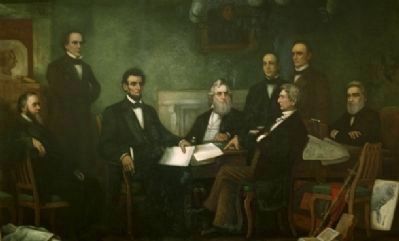
Photographed By Francis Bicknell Carpenter (Oil, 108x180 inches), 1864
7. First Reading of the Emancipation Proclamation of President Lincoln
Shown from left to right are Edwin McMasters Stanton, secretary of war; Salmon Portland Chase, secretary of the treasury; Lincoln; Gideon Welles, secretary of the navy; Caleb Blood Smith, secretary of the interior; William Henry Seward, secretary of state; Montgomery Blair, postmaster general; and Edward Bates, attorney general.
Arkansas, Texas, Louisiana, (except the Parishes of St. Bernard, Plaquemines, Jefferson, St. Johns, St. Charles, St. James Ascension, Assumption, Terrebonne, Lafourche, St. Mary, St. Martin, and Orleans, including the City of New Orleans) Mississippi, Alabama, Florida, Georgia, South-Carolina, North-Carolina, and Virginia, (except the fortyeight counties designated as West Virginia, and also the counties of Berkley, Accomac, Northampton, Elizabeth-City, York, Princess Ann, and Norfolk, including the cities of Norfolk and Portsmouth[)], and which excepted parts, are for the present, left precisely as if this proclamation were not issued.
And by virtue of the power, and for the purpose aforesaid, I do order and declare that all persons held as slaves within said designated States, and parts of States, are, and henceforward shall be free; and that the Executive government of the United States, including the military and naval authorities thereof, will recognize and maintain the freedom of said persons.
And I hereby enjoin upon the people so declared to be free to abstain from all violence, unless in necessary self-defence; and I recommend to them that, in all cases when allowed, they labor faithfully for reasonable wages.
And I further declare and make known, that such persons of suitable condition, will be received into the armed service of the United States to garrison forts, positions, stations, and other places, and to man vessels of all sorts in said service.
And upon this act, sincerely believed to be an act of justice, warranted by the Constitution, upon military necessity, I invoke the considerate judgment of mankind, and the gracious favor of Almighty God.
In witness whereof, I have hereunto set my hand and caused the seal of the United States to be affixed.
Done at the City of Washington, this first day of January, in the year of our Lord one thousand eight hundred and sixty three, and of the Independence of the United States of America the eighty-seventh.
By the President: ABRAHAM LINCOLN
WILLIAM H. SEWARD, Secretary of State.
— Submitted April 10, 2011.
Additional keywords. Archer Alexander; Reconstruction; Frederick Douglass.
Credits. This page was last revised on January 30, 2023. It was originally submitted on April 21, 2007, by J. J. Prats of Powell, Ohio. This page has been viewed 9,505 times since then and 52 times this year. Last updated on April 10, 2011, by Richard E. Miller of Oxon Hill, Maryland. Photos: 1, 2, 3, 4, 5, 6. submitted on April 21, 2007, by J. J. Prats of Powell, Ohio. 7. submitted on April 10, 2011, by J. J. Prats of Powell, Ohio. • Bill Pfingsten was the editor who published this page.
